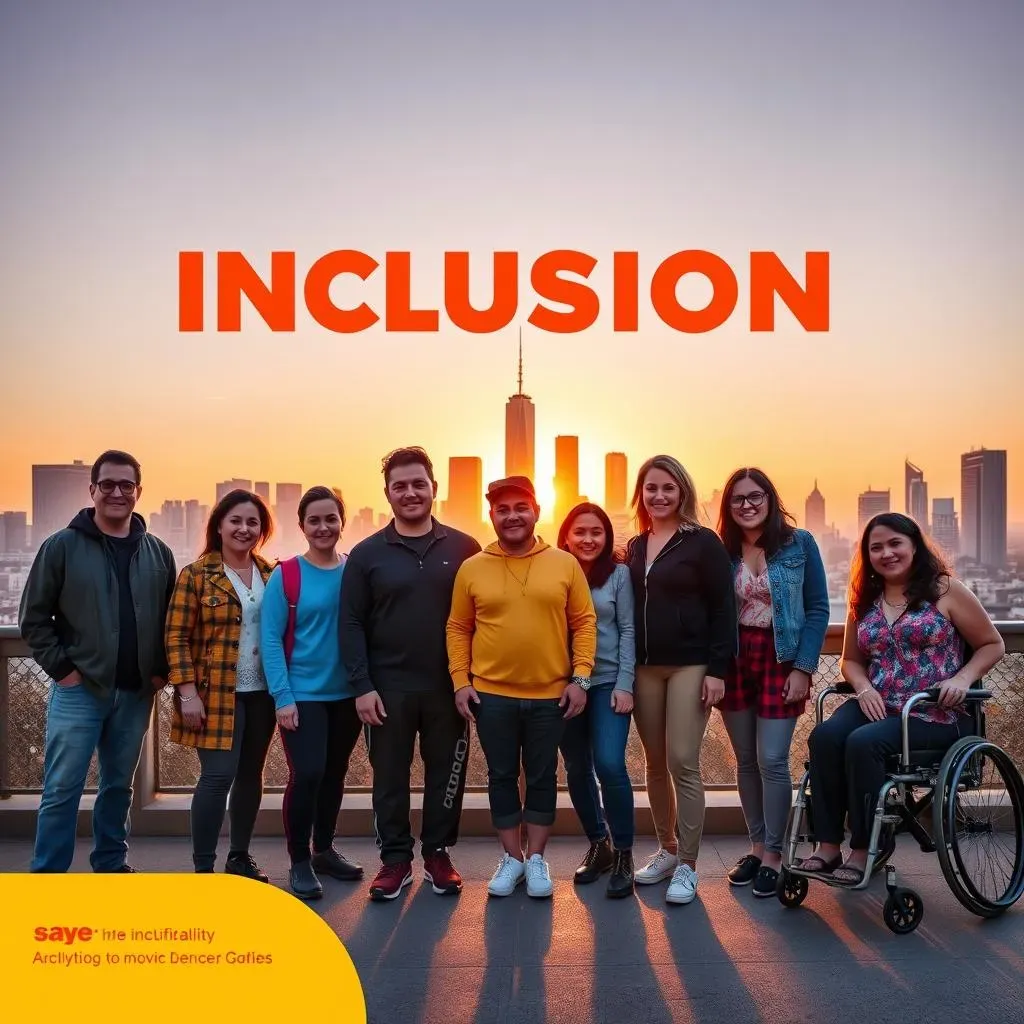Table of Contents
In a world often quick to overlook the needs and experiences of people with disabilities, the power of celebrity advocacy shines brightly. This article explores the multifaceted landscape of celebrity disability awareness campaigns, examining their impact on public perception, policy, and the lives of individuals navigating disability. We'll journey through compelling examples of successful campaigns, analyzing what makes them effective and identifying areas for improvement. We'll discuss the challenges inherent in using celebrity influence for social change, considering both the positive and negative aspects of these high-profile initiatives. From insightful case studies of impactful celebrity disability awareness campaigns to a forward-looking perspective on the future of disability advocacy, this exploration aims to illuminate the crucial role celebrities play in fostering a more inclusive and understanding society. Prepare to discover how these campaigns shape conversations, challenge preconceptions, and ultimately, pave the way for a more equitable world for people with disabilities. Get ready to dive into the fascinating and often complex world of celebrity disability awareness campaigns and their lasting impact.
Celebrity Disability Awareness Campaigns: Shining a Light on Inclusion

Celebrity Disability Awareness Campaigns: Shining a Light on Inclusion
Raising Visibility: The Power of Celebrity Representation
Celebrities with disabilities using their platforms to share their stories and experiences is incredibly powerful. It challenges stereotypes and shows the world that disability is a part of the human experience, not something to be hidden or feared. Think about actors like RJ Mitte, who openly discussed his cerebral palsy while starring in "Breaking Bad," or Paralympic athletes who inspire millions with their athletic achievements. Their visibility normalizes disability and helps create a more inclusive society. It's not just about awareness; it's about changing hearts and minds.
These campaigns aren't just about raising awareness, they're about changing the narrative. For too long, disability has been portrayed negatively in the media, often reinforcing harmful stereotypes. Celebrity involvement helps shift that perspective, showcasing the talent, resilience, and everyday lives of individuals with disabilities. This positive representation makes a tangible difference in how people perceive disability and encourages greater acceptance and understanding.
Celebrity | Disability | Campaign Focus |
|---|---|---|
RJ Mitte | Cerebral Palsy | Disability representation in media |
Nyle DiMarco | Deaf | Deaf awareness and inclusion |
Jamie Brewer | Down Syndrome | Challenging stereotypes and promoting inclusion |
Amplifying Voices: Giving a Platform to the Disability Community
Many celebrity campaigns go beyond simply raising awareness; they actively collaborate with disability organizations and individuals. This collaboration ensures that the message is authentic and reflects the lived experiences of the community. It's about more than just a celebrity lending their name; it's about providing a platform for the voices of those most affected by disability-related issues. This collaborative approach is key to creating truly impactful campaigns.
This collaborative approach is essential. It ensures that the message is authentic and reflects the lived experiences of the disability community. By working alongside disability rights organizations and individuals with disabilities, celebrities ensure that their campaigns are not only impactful but also respectful and accurate. It’s a partnership that amplifies the voices and concerns of those who often feel unheard.
- Partnering with disability organizations
- Featuring stories from individuals with disabilities
- Supporting inclusive policies and legislation
Beyond Awareness: Driving Action and Change
The ultimate goal of any successful campaign isn't just to raise awareness; it's to drive meaningful change. This means advocating for policies that promote inclusion, accessibility, and equal opportunities for people with disabilities. It means challenging discrimination and prejudice wherever it arises. Celebrity campaigns can be incredibly effective in this regard, bringing significant attention to important issues and influencing public opinion.
Effective campaigns are not just about raising awareness; they translate that awareness into tangible action. This might involve advocating for specific legislation, supporting charities dedicated to disability rights, or promoting accessible products and services. It's about using the platform to push for systemic changes that truly improve the lives of individuals with disabilities. The ultimate measure of success is not just increased awareness, but real-world improvements in accessibility and inclusion.
Analyzing the Impact: Successes and Shortcomings of Celebrity Disability Awareness Campaigns

Analyzing the Impact: Successes and Shortcomings of Celebrity Disability Awareness Campaigns
Measuring Success: Tangible Outcomes and Lasting Change
One of the biggest challenges in evaluating celebrity disability awareness campaigns is defining "success." Is it simply increased social media engagement, or are we looking for tangible changes in policy, accessibility, or societal attitudes? Some campaigns demonstrably shift public opinion, leading to increased funding for disability services or the passage of inclusive legislation. For example, a campaign featuring a high-profile athlete with a disability might inspire more young people with disabilities to pursue their athletic dreams. Measuring this ripple effect is complex but crucial for understanding true impact.
Truly successful campaigns often demonstrate a long-term impact, not just a fleeting surge in awareness. They build on existing advocacy efforts, creating sustained momentum toward meaningful change. We need to look beyond immediate media buzz and assess whether the campaign has contributed to lasting shifts in attitudes, policies, or access to resources for the disability community. The most effective campaigns are those that create ongoing dialogues and inspire sustained action, long after the initial media spotlight fades.
Metric | Indicator of Success | Indicator of Shortcoming |
|---|---|---|
Policy Change | New legislation promoting accessibility | No changes in relevant laws or regulations |
Funding Increases | Increased government or private funding for disability services | No significant increase in funding |
Attitudinal Shifts | Improved public perception of disability, reduced stigma | Persistence of negative stereotypes and discrimination |
The Pitfalls of Tokenism and Misrepresentation: Avoiding Harmful Effects
While celebrity involvement can be powerful, it's crucial to avoid tokenism. Simply featuring a person with a disability in an advertisement without genuine engagement with the disability community can be more harmful than helpful. It can perpetuate superficial representations and reinforce stereotypes rather than challenging them. Authenticity is paramount; campaigns must be developed in collaboration with disability organizations and individuals with lived experience to ensure accurate and respectful portrayals.
Another significant shortcoming is the potential for misrepresentation. Celebrities might inadvertently perpetuate harmful stereotypes or misunderstandings about specific disabilities. For instance, focusing solely on the inspirational aspects of overcoming disability while ignoring the systemic barriers faced by the community can be misleading and ultimately counterproductive. A balanced and nuanced approach is essential, acknowledging both the challenges and the triumphs of living with a disability.
- Ensure authentic representation, not tokenism
- Collaborate with disability organizations and individuals
- Avoid perpetuating harmful stereotypes
- Present a balanced and nuanced perspective
Sustaining Momentum: From Awareness to Actionable Change
Many campaigns generate significant initial buzz but fail to maintain momentum. Sustained engagement is key to translating awareness into lasting change. This requires a long-term strategy that extends beyond the initial media campaign. It involves ongoing advocacy, community building, and collaboration with disability organizations. The impact of a campaign should be measured not just by its immediate reach, but by its lasting contribution to the disability rights movement.
Effective campaigns often involve multiple stakeholders, including celebrities, disability organizations, policymakers, and the broader public. This collaborative approach ensures that the campaign's message is amplified and reaches a wider audience. It also creates a sense of shared responsibility for driving change, fostering a more sustainable and impactful movement for disability rights. A holistic approach is key for long-term success.
The Future of Advocacy: How Celebrities Can Continue to Drive Change in Disability Awareness Campaigns

The Future of Advocacy: How Celebrities Can Continue to Drive Change in Disability Awareness Campaigns
Embracing Authentic Partnerships: Moving Beyond Tokenism
The future of effective celebrity disability awareness campaigns hinges on genuine collaboration. It's no longer enough for celebrities to simply lend their name to a cause; they need to actively engage with disability organizations and individuals with lived experience. This means actively seeking out partnerships with organizations representing diverse disability communities, ensuring their voices are central to the campaign's messaging and strategy. This shift towards authentic partnerships will lead to more nuanced, impactful, and respectful campaigns that resonate deeply with the community they aim to serve.
Imagine a campaign where a celebrity doesn't just appear in a commercial, but actively participates in workshops, attends community events, and engages in meaningful dialogue with disability advocates. This active participation fosters trust and ensures that the campaign's message aligns with the lived realities of people with disabilities. Such genuine engagement transcends the limitations of surface-level awareness campaigns and fosters a more lasting and meaningful impact.
Type of Partnership | Benefits | Example |
|---|---|---|
Disability Organization Collaboration | Authentic messaging, access to community expertise | Partnering with a national disability rights organization |
Individual Advocate Collaboration | Personal stories, lived experience insights | Featuring interviews with individuals with disabilities |
Policymaker Engagement | Advocacy for inclusive legislation | Supporting bills promoting accessibility and inclusion |
Leveraging Digital Platforms for Inclusive Storytelling: Beyond Traditional Media
Digital platforms offer unprecedented opportunities for inclusive storytelling. Celebrities can utilize social media, podcasts, and online videos to share diverse narratives from within the disability community. This provides a powerful way to challenge stereotypes and celebrate the contributions of people with disabilities. Moving beyond traditional media allows for a more direct and engaging connection with a wider audience, fostering more inclusive conversations and promoting a more profound understanding of disability.
Imagine a celebrity using their Instagram account to highlight the achievements of young people with disabilities, or a podcast featuring interviews with individuals who have overcome significant challenges. This direct and personal approach can be far more powerful than a 30-second television commercial. By embracing digital platforms, celebrities can reach a global audience and ensure that diverse voices are amplified, leading to a more inclusive and representative portrayal of disability.
- Utilizing social media for storytelling
- Creating inclusive online content
- Promoting accessible digital platforms
- Engaging with disability communities online